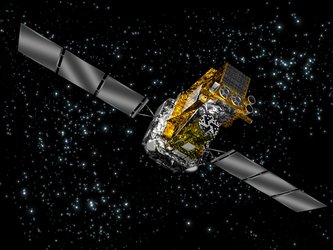XMM-Newton watches lazy pulsar being jazzed up by companion
XMM-Newton has, for the first time, detected signals from both stars of a binary pulsar system in X-rays, unveiling a scientific goldmine. Each star of the closely-packed system is a dense neutron star, spinning extremely fast, radiating X-rays in pulses.
The binary pulsar
To see two pulsars orbiting each other in a binary system is extremely rare in itself.
Each pulsar or neutron star is the fast-rotating, dead heart of a once-massive star. “These stars are so dense that one cup of neutron star-stuff would outweigh Mt. Everest,” says Alberto Pellizzoni, lead author of the article where the results are reported. “Add to that the fact that the two stars are orbiting really close to each other, separated by only 3 light-seconds, about three times the distance between Earth and the Moon.”
One cup of neutron star-stuff would outweigh Mt. Everest. Add to that the fact that they're orbiting really close, separated by only about three times the distance between Earth and the Moon.
The system is a goldmine for scientists; the perfect laboratory for high-energy physics and a never-ending source of intriguing physical problems.
XMM-Newton discovered X-ray emission from both pulsars in October 2006. What Pellizzoni’s team saw could not be explained by the workings of pulsar A alone, which was known to be the only significant power plant in the system. Besides, the X-ray pulses detected from pulsar B were too strong. The energy that it lost by rotation could not account for all the X-ray radiation observed. That the observed X-rays might originate from residual internal heat of this 50 million year-old pulsar was also ruled out.
Pulsar B is an oddity, in that it is very different from a ‘normal’ pulsar. “One possible solution for the mystery could be mutual interaction between the two stars, where the lazy star derives energy from the other,” says Pellizzoni. Pulsar B's X-ray emission might be visible because pulsar A's wind intercepts the magnetosphere of pulsar B, powering pulsar B's wind and heating up the neutron star’s surface.

The fundamental physical processes involved in these extreme interactions are a matter of debate among theoretical physicists. But now, with XMM-Newton's observations, scientists have gained new insight, providing a new experimental setting for them. In X-rays, it will be possible to study the subsurface and magnetospheres of the stars as well as the interaction between the two in that close, heated environment.
Given how close and dense the stars of its system are, PSR J0737-3039 is of great interest for the study of theories of strong-field gravity. Future tests of general relativity by radio observations of this system will supersede the best Solar System tests available. It is also a unique laboratory for studies in several other fields, ranging from the equation of state of super-dense matter to magneto-hydro dynamics.
Notes for editors:
The findings appear in ‘PSRJ0737−3039: Interacting pulsars in X-rays’ by A. Pellizzoni, A. Tiengo, A. De Luca, P. Esposito, and S. Mereghetti, published in the Astrophysical Journal in May 2008.
For more information:
Alberto Pellizzoni, INAF/IASF, Milan, Italy
Email: alberto @ iasf-milano.inaf.it
Norbert Schartel, ESA XMM-Newton Project Scientist
Email: Norbert.Schartel @ esa.int














